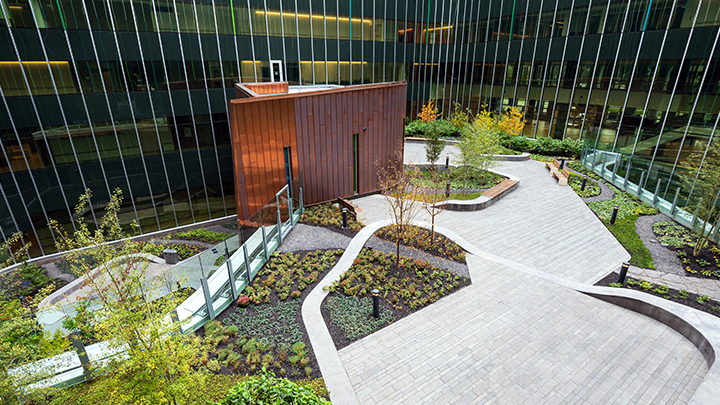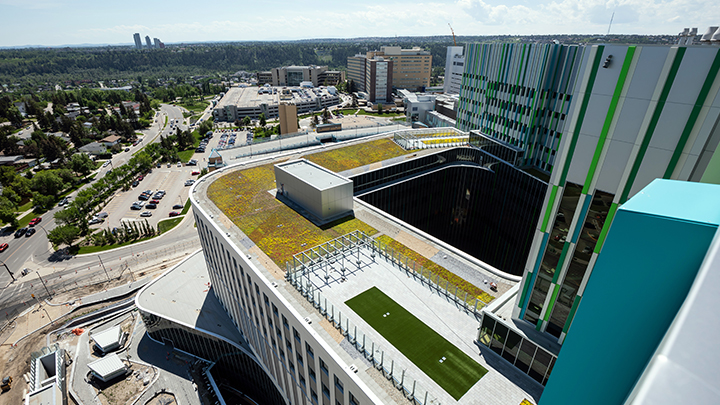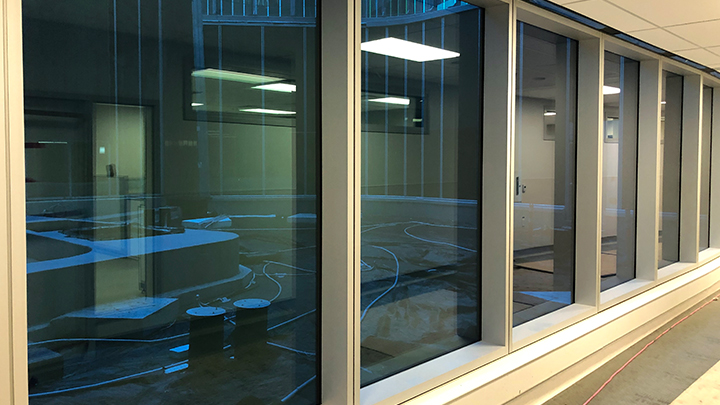
May 20, 2024

The new Arthur J.E. Child Comprehensive Cancer Centre has more than 6,200 square metres of outdoor accessible spaces, ensuring patient, families, visitors and staff can connect with nature and heal in a relaxing environment. It is slated to open for service this coming fall. Photo Supplied.

Operating environmentally sustainable facilities not only helps to reduce greenhouse gas emissions and the environmental footprint, it will reduce operating costs for the Arthur Child, putting savings back into the healthcare system. Photo Supplied.

The Arthur Child’s design sees the building operate 26 per cent more efficiently than a similar-sized commercial building. Heat loss is also reduced through a low window-to-wall ratio of 24 per cent. Photo Supplied.
Story by Jennifer Green
CALGARY — The new Arthur J.E. Child Comprehensive Cancer Centre (Arthur Child) has garnered a top environmental honour, LEED Gold Status, for its energy and sustainability features.
The Arthur Child is a prime example of Alberta Health Services’ (AHS) dedication to fiscal responsibility through environmentally sustainable features, all designed to contribute to reduced greenhouse gas emissions and a smaller environmental footprint as well as significant savings in operational costs. These cost savings ultimately benefit the healthcare system, ensuring that resources can be efficiently directed back into front-line care.
According to the Canada Green Building Council, LEED (Leadership in Energy and Environmental Design) is an international symbol of sustainability excellence and green building leadership. “LEED’s proven and holistic approach helps virtually all building types lower carbon emissions, conserve resources, and reduce operating costs by prioritizing sustainable practices.” Gold Status is the highest designation.
The design of the Arthur Child — scheduled to open for service this coming fall — aims to create a healing environment that connects patients, families, visitors, and staff with nature. The facility boasts more than 6,200 square meters of outdoor accessible spaces, a ground-floor outdoor garden, and an eighth-floor green space with public access. Natural light floods the facility, creating a calming and fresh environment that’s therapeutic in itself.
Indoor air quality is also a top priority at the Arthur Child.
“We have 100-per-cent outside air (coming into the building); it’s an innovation of buildings in this era that weren’t in healthcare facilities in days gone by,” says Dave Campbell, lead engineering liaison for AHS.
Innovative flooring at main entrances captures dirt and particulates to preserve pristine air quality. High-efficiency filtration systems and an HVAC system designed to use 100-per-cent fresh air ensure that the air within the facility is not recycled, which reduces the risk of airborne transmissible diseases. Air is then exhausted after passing through 'heat wheels,' to minimize energy consumption.
Water efficiency is another plus of the Arthur Child's sustainable design. Landscaping with drought-resistant plants and efficient watering technologies are expected to save more than 700,000 litres of potable water annually.
“In the building we have ultra-low-flow showers, urinals and toilettes, therefore, saving water,” says Maciej Burzynski, project director, Alberta Infrastructure. This will contribute to an annual savings of more than 34 million litres of water, the equivalent of 14 Olympic-sized swimming pools.
Energy efficiency lies at the core of the Arthur Child's design, with the building operating 26 per cent more efficiently than a similar-sized commercial structure. This remarkable efficiency is achieved through various strategies, including a low window-to-wall ratio, energy-efficient HVAC systems and LED lighting. The choice of energy-efficient LED lights not only reduces energy consumption, but also minimizes environmental impact, as they are mercury-free and enjoy longer lifespans.
The LEED Gold Status achieved by the Arthur Child reflects AHS’ belief that patient well-being, green initiatives and environmental responsibility can go hand in hand.
Read our Green and Healthy Building Design Brief. Learn more about LEED.